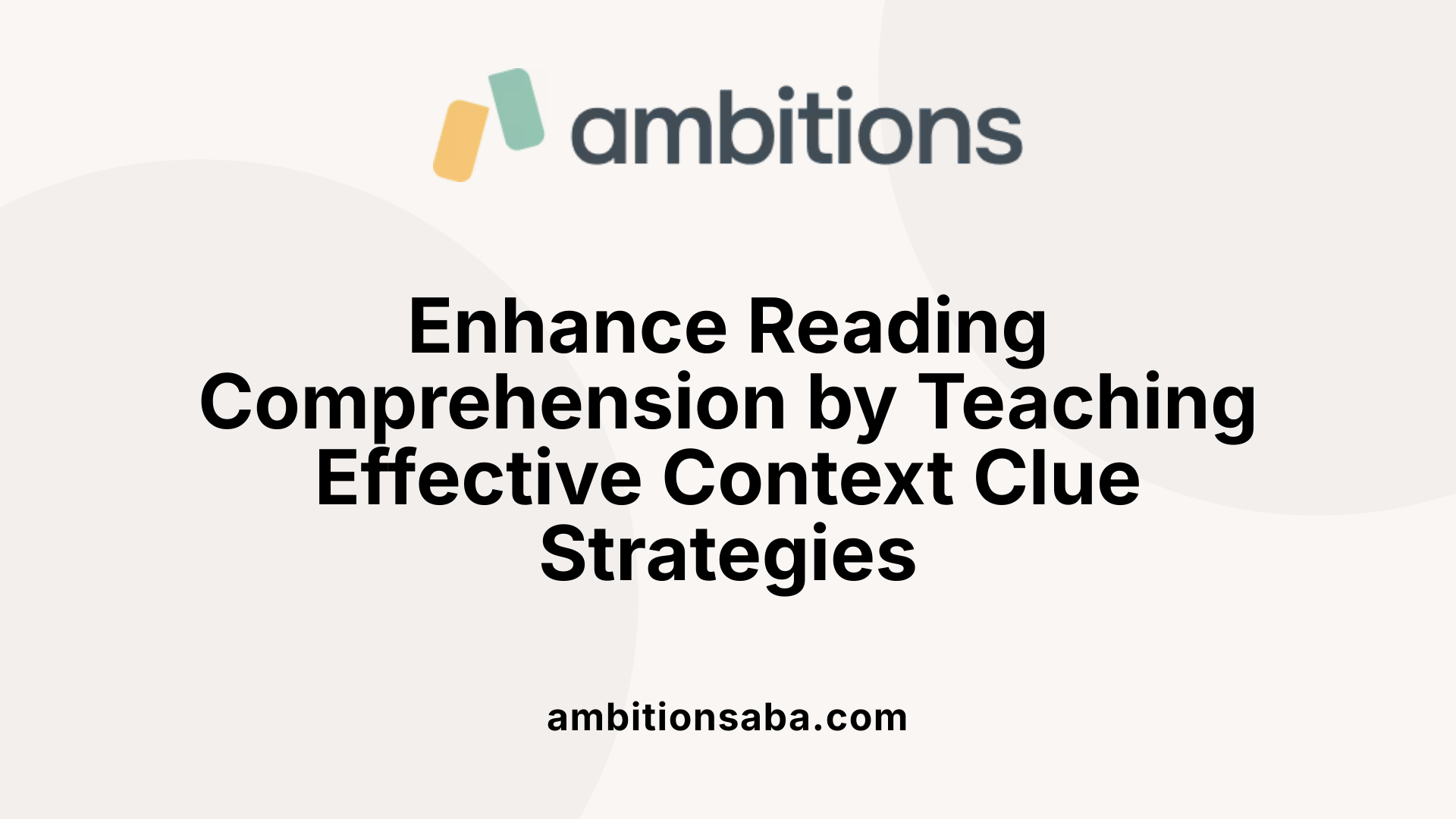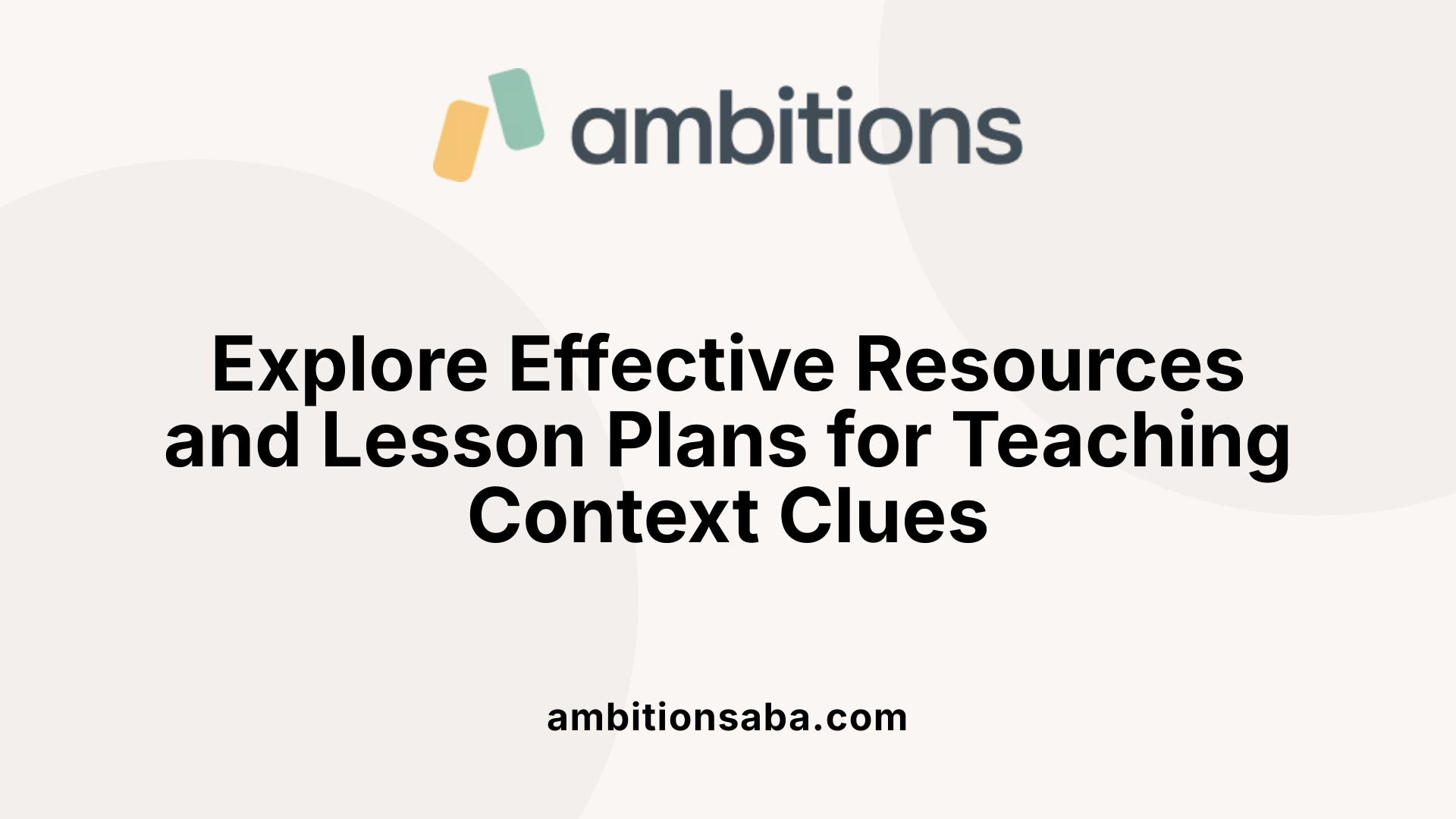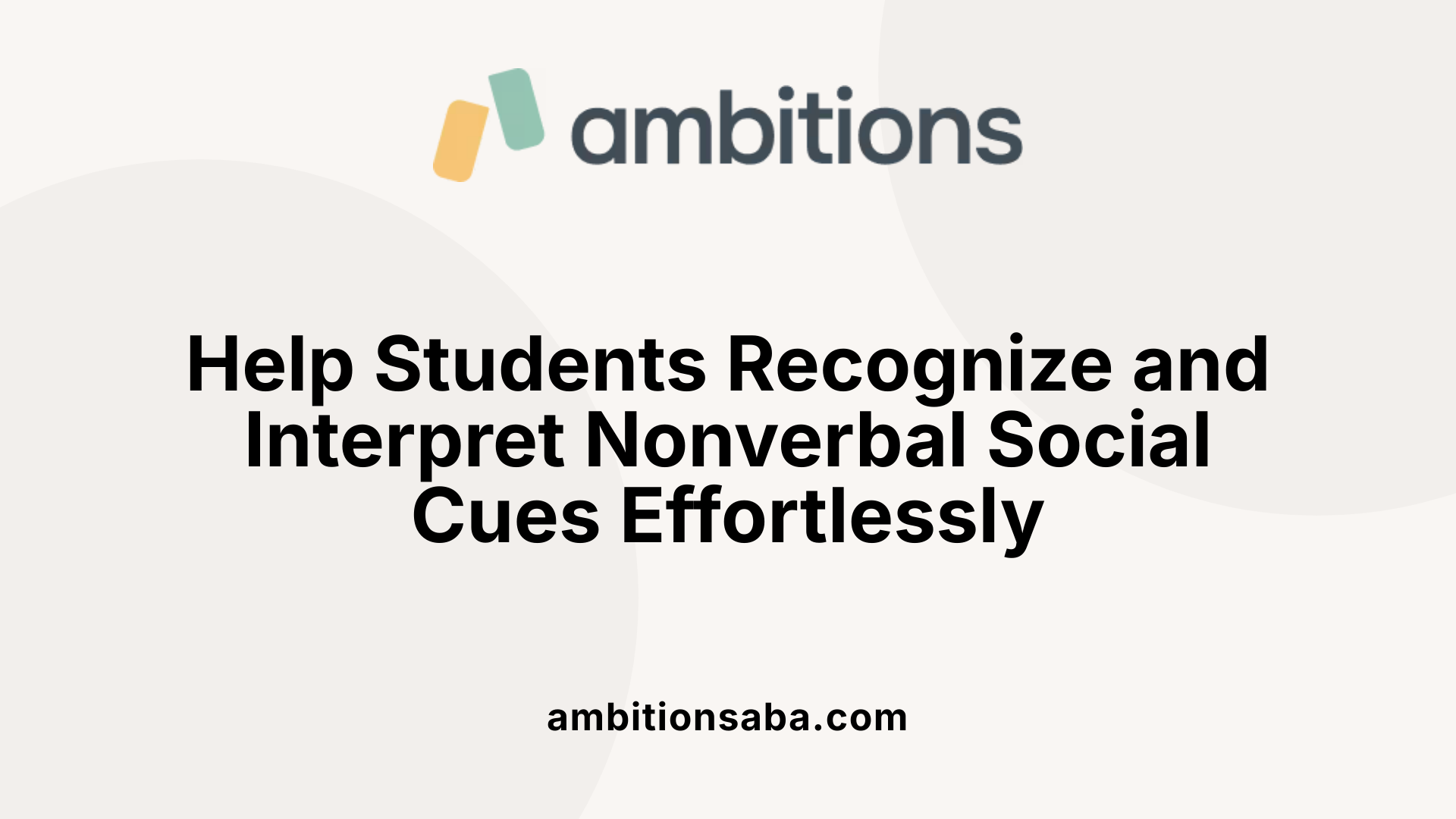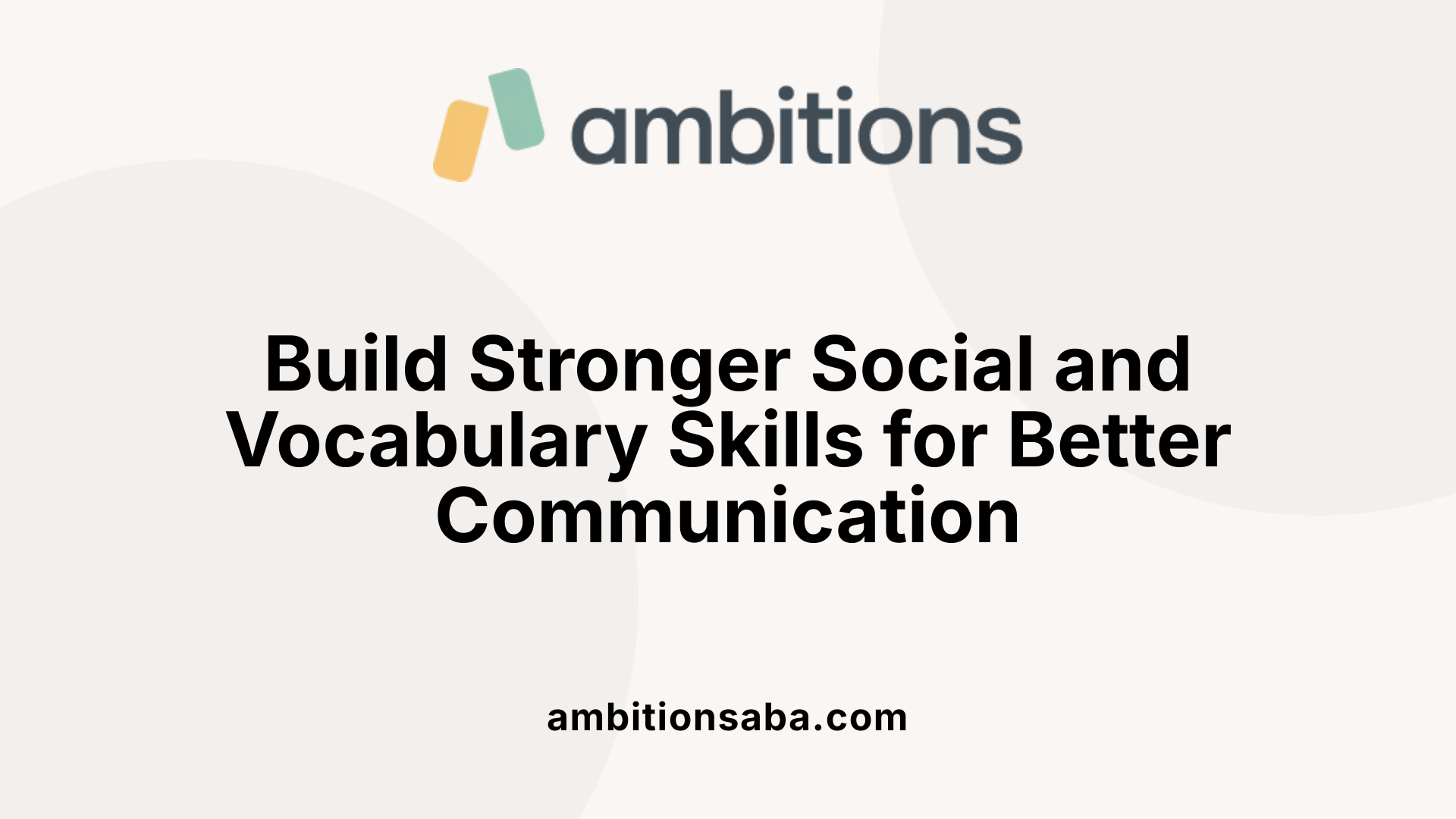Supporting Success: Tailoring Transition Planning for Teens with Disabilities via ABA
Understanding and Teaching Context and Social Cues
Reading social settings and understanding context clues are essential skills that significantly improve communication, social interaction, and emotional intelligence. Educators are increasingly integrating strategies that foster these competencies, employing a variety of resources and practical activities to support diverse learners. This article explores effective approaches to teaching context clues within social environments, the resources available, and methods to help students recognize and interpret social cues, ultimately promoting better social understanding and competence.
Approaches to Teaching Context Clues in Social Settings

What are effective approaches to teaching students how to use context clues to improve reading comprehension?
Teaching students to effectively use context clues within social settings and reading contexts can significantly boost their understanding and interaction skills. Research by Kuhn & Stahl (1998) highlights that the practice of using context—rather than merely categorizing clues—benefits students by promoting comprehension.
One of the most effective methods involves explicit instruction on the various types of clues, such as definitions, synonyms, antonyms, examples, and inferencing. Visual aids like anchor charts and graphic organizers help clarify these categories, making abstract concepts more concrete for learners.
In addition to direct instruction, modeling strategies through think-alouds allows teachers to demonstrate how to identify and interpret clues in real time. Following this, guided practice activities such as sentence search exercises or partner discussions help students apply these skills actively and collaboratively.
Incorporating digital tools and visual aids further supports comprehension. For instance, highlighting clues in digital texts or pairing images with words helps students connect context to meaning both visually and textually.
Routine practice is central to developing independence. Activities like
Resources and Lesson Plans for Teaching Context Clues
 Many instructional materials are available online to help teachers guide students in understanding and using context clues effectively. For example, free PDFs like "The Complete Guide to Teaching Context Clues" provide comprehensive ideas, classroom activities, and recommended book lists tailored for different grade levels.
Many instructional materials are available online to help teachers guide students in understanding and using context clues effectively. For example, free PDFs like "The Complete Guide to Teaching Context Clues" provide comprehensive ideas, classroom activities, and recommended book lists tailored for different grade levels.
Specifically designed lesson plans for grades 3 to 5 integrate various teaching strategies. These include using sentence strips, anchor charts, and diverse texts—both fiction and informational—to promote active engagement and reinforce learning.
Visual aids play a crucial role in making these lessons clear. Teachers often incorporate sentence strips and anchor charts that highlight different types of clues, such as definitions, appositives, and examples. These tools help students visually connect clues with their meanings.
Activities like partner practice, themed exercises, and reading aloud sessions encourage interactive participation. Students are guided through steps such as underlining or highlighting clues within sentences, improving their ability to recognize and analyze context cues.
Digital tools and worksheets are also valuable resources. They allow students to practice identifying clues independently or in groups, whether through interactive software or printable handouts. These resources support explicit instruction on how to decode unfamiliar words through context.
Focusing on a variety of texts—both fiction and informational—provides students with diverse opportunities to encounter context clues. This variety helps solidify their understanding and supports transfer of skills to new reading situations.
Overall, available teaching resources emphasize active, explicit instruction, including modeling how to identify clues, and encourage diverse classroom activities. These strategies aim to improve students’ vocabulary and comprehension skills by making decoding strategies relatable and engaging.
Teaching Strategies for Recognizing and Using Context Clues in Language Learners
What methods are effective for teaching language learners to identify and use context clues?
Teaching students, especially language learners, to effectively identify and utilize context clues requires a combination of clear instructional strategies and engaging activities. One proven approach is explicit instruction on the different types of clues, such as definitions, synonyms, antonyms, examples, inferences, and categories. Educators can help students recognize these clues within authentic texts, making the learning process meaningful.
Visual supports play a crucial role. Using anchor charts and classroom displays that categorize types of clues can serve as handy references during reading activities. These tools make abstract concepts more concrete, particularly for students who are developing their language skills.
Modeling strategies like self-questioning encourages students to actively analyze texts. Teachers can demonstrate how to ask questions like, 'What clues are around this unfamiliar word?' or 'How does this sentence give me hints about the word's meaning?' This modeling helps students develop their own strategies for extracting relevant hints.
Active, hands-on activities reinforce these skills. For example, students can underline or highlight clues within sentences, then create their own sentences incorporating new vocabulary based on the clues they identified. Collaborative discussions around these activities can deepen understanding.
Exposing students to varied contexts—such as different genres or subject areas—bresents multiple opportunities to encounter target words and their clues. Using digital tools like highlighting apps or online quizzes can also support independent practice, offering immediate feedback and repeated exposure.
Importantly, teaching should emphasize the primary purpose of context clues: improving overall comprehension. Instead of focusing solely on decoding individual words, instruction should help students understand how clues contribute to understanding the text as a whole. This approach fosters confident, autonomous readers who can navigate new vocabulary effectively and with comprehension in mind.
By integrating these strategies—explicit teaching, visual aids, active practice, contextual diversity, and technology—educators can support language learners in developing strong skills in recognizing and using context clues, thereby enhancing their overall reading comprehension.
Teaching Social Cues: Methods and Activities for Social Skills Development

What strategies can be employed to teach social cues and enhance social understanding?
Effective teaching of social cues involves several interactive and explicit methods. One primary approach includes explicit instruction combined with modeling. Teachers demonstrate how to recognize and interpret social cues such as facial expressions, body language, vocal tone, and personal space.
Role-playing activities enable students to practice these skills in simulated situations, allowing them to apply what they've learned in a safe environment. Engaging students with social stories and scenarios helps them understand different social contexts and appropriate responses.
Activities like 'Emotion Charades' or 'One Word Story' foster observational skills and encourage students to identify and respond to social cues in engaging ways. Observation and group discussions about body language and facial expressions enhance understanding and help students recognize subtle non-verbal signals.
Additionally, activities should be adaptable to cultural and individual differences. Recognizing that social cues may vary across cultures or personal experiences ensures respectful and effective communication.
Structured group activities and peer interactions promote social skills such as teamwork, sharing, and respectful communication. These interactions also provide real-life opportunities to practice interpreting social cues.
For children with special needs, such as those on the autism spectrum, tailored strategies are essential. Systematic social skills programs and behavioral therapies like applied behavioral analysis (ABA) offer structured learning to develop social competence.
Supporting social cues understanding not only builds social-emotional skills but also contributes to better relationships, empathy, and conflict resolution. Overall, a combination of explicit teaching, experiential activities, and sensitive adaptation to individual needs creates a comprehensive approach to social skills development.
Recognizing and Interpreting Social Cues in Social Environments

How can educators help students recognize and interpret social cues in social environments?
Educators play a vital role in helping students develop the skill to recognize and interpret social cues. One effective approach involves teaching students to observe body language and facial expressions carefully, emphasizing how these nonverbal signals communicate feelings and intentions. For example, noticing a student’s crossed arms or a frown can indicate discomfort or disagreement.
Using visual aids, such as social stories, can clarify different social signals. Role-playing activities further enhance understanding by allowing students to practice recognizing cues like tone of voice, eye contact, or gestures in a controlled setting. These methods provide a safe space for students to experiment and receive feedback.
It’s also important to include discussions about cultural and situational differences. Recognizing that cues like eye contact or personal space vary across cultures broadens students’ awareness and reduces misinterpretation.
Guided observation with feedback helps students refine their skills. Teachers can facilitate activities where students observe peers or videos, then discuss what cues they noticed and what they might mean.
Practicing social scenarios with classmates fosters real-life application. Activities such as 'Emotion Charades' or 'Role Reversal' enable students to identify emotions and respond appropriately.
Reflection questions encourage deeper understanding, asking students to consider how social cues influence interactions and how they might respond in similar situations. Incorporating these strategies systematically creates a comprehensive approach to enhancing social competence in diverse environments.
Integrating Social and Vocabulary Skills for Holistic Social Literacy

Why are social cues important for developing social skills?
Understanding social cues is essential for effective social skills, as they help individuals interpret others’ emotions, intentions, and reactions accurately. Nonverbal signals like facial expressions, body language, eye contact, and tone of voice provide vital information that guides appropriate responses in social interactions.
Recognition of these cues allows for more empathetic communication, fostering stronger personal and professional relationships. When people can read cues such as a smile indicating friendliness or a frown showing disapproval, they can adjust their behavior accordingly, which promotes positive interactions.
Practicing and observing these cues—possibly with feedback from teachers or therapists—helps individuals become more confident and competent socially. Building these skills is particularly important for those with neurodevelopmental or emotional challenges, as it supports better understanding and engagement within social environments.
How do context clues and social understanding connect?
Both vocabulary and social cues rely heavily on context. Just as students use surrounding words, phrases, or images to decode unfamiliar vocabulary, they also interpret social cues within the broader social situation.
Activities that focus on meaningful contexts—such as reading stories, engaging in role-plays, or analyzing social scenarios—enhance this understanding. For example, recognizing the context of a classroom activity can help decode potential social behaviors or vocabulary related to that situation.
This integrated approach helps learners transfer skills across different settings, improving comprehension and social competence simultaneously.
What activities combine vocabulary learning and social skills?
Classrooms can employ various engaging activities to develop both vocabulary and social skills. For instance:
- 'Monkey See, Monkey Do' involves imitating facial expressions and gestures to recognize emotions.
- 'Emotion Charades' encourages students to act out feelings, fostering understanding of social cues.
- 'One Word Story' prompts students to communicate social or emotional themes with a single word, emphasizing context.
Incorporating songs and stories also helps students practice identifying clues within engaging content, reinforcing their ability to use clues in real-life situations.
What strategies can teachers use in the classroom?
Effective teaching involves explicit modeling of how to identify and interpret social cues, much like teaching decoding strategies for vocabulary. Teachers can demonstrate reading facial expressions or interpreting tone before students practice in controlled activities.
Creating opportunities for discussion in authentic reading contexts, such as analyzing character behaviors or social scenarios in texts, encourages students to apply these skills meaningfully.
Moreover, integrating social cue recognition into vocabulary lessons—by highlighting contextual clues—can make learning more relevant and holistic. Regularly practicing these skills helps students become more independent in understanding both spoken and social language cues.
| Focus Area | Activities/Strategies | Purpose | Examples |
|---|---|---|---|
| Vocabulary & Context | Reading sentences and underlining clues | To improve decoding of unfamiliar words | Highlighting definitions or synonyms within texts |
| Social Cues | Emotion charades and facial expression exercises | To recognize and interpret emotions | Acting out emotions, discussing facial expressions |
| Combined Skills | Role-plays that require vocabulary and social interaction | To practice applying clues in social situations | Recreating social scenarios from stories |
Harnessing these integrated approaches helps students become more confident, empathetic, and skilled communicators in their everyday lives.
Building Social Literacy Skills for the Future
Mastering both context clues and social cues is vital for fostering effective communication and social competence. Educators play a crucial role by providing explicit instruction, engaging activities, and varied resources that help learners interpret and respond within social environments confidently. As students develop these skills, they become more empathetic, socially aware, and capable of navigating diverse social settings, laying a foundation for lifelong skill development and successful interpersonal relationships.
References
- Context Clues Definition, Examples & Lesson Plan Ideas
- Recognizing Social Cues For Better Skills
- Free Context Clues Worksheet & Lesson Plan
- Teaching Children About Reading Social Cues
- Recognizing Social Cues For Better Skills
- How to Read Social Cues to Build Better Relationships
- What is the Importance of My Child Understanding Social ...

